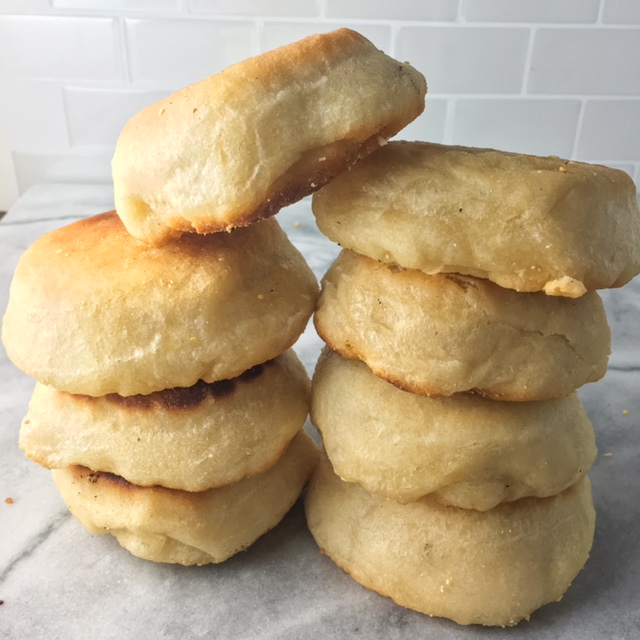Let’s just cut to the chase, because I know we’re all busy here. These are the VERY best english muffins I’ve ever had. In fact, they’re the very best english muffins anyone has ever had. They’re that good – so good that I’m completely confident in speaking for everyone else on the planet when I proclaim their unanimous superiority, far and away out-muffin-ing any other english muffin that has ever existed.
I first tried these at a bakery in Napa called The Model Bakery. Now normally, I’m not the type of girl who goes into a bakery and orders an english muffin. I mean, who does that?? No, I’m the girl who carefully examines all the nummy options before finally settling on the most enticing cookie or tartlet or brownie or lemon square in the whole damn place. In my world, one goes into a bakery for a treat…and english muffins do not meet my standard treat qualifications. There’s no chocolate, no flaky butter crust, no ooey or gooey of any kind. An english muffin can’t stand on its own. It requires butter, it requires jam. You need a whole assortment of spreads and toppings to make the english muffin shine. So needless to say, when my friend insisted I try hers, I obliged solely because it was her birthday…and you always do what the birthday girl says.
One little bite, I conceded. Ummmmmm, it was amazing. Magic. Fireworks. Imaginary songbirds fluttering excitedly above my head, now perched high up in the fluffy, cotton-candy clouds. This was the unicorn of english muffins. Puffy, pillowy soft and fabulously flavorful, with a buttery, golden crust expertly seared into each side. I immediately ordered one of my very own, returning again the next morning for yet another. Then I was forced to return home, home to a cold, dark land of no english muffins. I couldn’t get them out of my head. I HAD to get another fix. So naturally, I began scouring the net for the recipe, when what luck – there was a cookbook! The Model Bakery cookbook, to be exact. And what was the feature recipe?? Why, their signature english muffins, of course. SCORE.
So I made them. And they were just as fabulous as I remembered. And I’m not being the least bit dramatic when I say that tears of joy were shed.
One of the bread-baking techniques I was introduced to with this recipe is the principle of the biga (pronounced bee-gah – you’re welcome). The biga is basically a thick, little ball of starter dough. You mix it up the day before you want to make your bread and stick it in the fridge overnight to do its thang. When mixed in with the rest of the dough ingredients the next day, it adds complexity of flavor, imparts a light, hole-y texture and even helps preserve the bread (not really necessary with these, as they’re so crazy delicious, they’re typically gone within a day anyhow). The biga makes a BIGa difference (yeah, I know you see what I did there).
Now, I’m gonna be honest: these aren’t one of those things you just whip up on a random Tuesday. They require time, planning and effort. There are multiple steps, and you’re working with yeast, which can really freak some people out. But not you. You’re gonna make this happen, because you need these english muffins in your life. Each time I’ve made these, my technique has gotten better and faster, so just take it easy on yourself. First, read the recipe allllllll the way through, make sure you’ve got your ducks in a row, then just go for it. Take one step at a time.
This is one of those life-changing recipes that makes you want to quit doing all the other things that cut into the time you could be using for english muffin consumption (like work and showering), in order to focus solely on the muffins. Try them, I beg of you. You’ll never look back.

| Servings |
muffins
|
Ingredients
|
   |